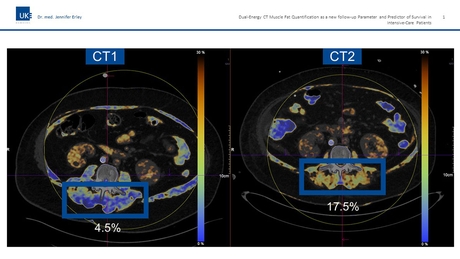A new parameter for evaluating muscle degradation in severely ill patients may be better than conventional radiological measures in predicting whether patients will survive.
"This is the first study to demonstrate that intramuscular fat quantified with dual-energy CT is indeed increasing in immobilized patients, and more importantly, may be superior to conventional radiological CT parameters in predicting survival" said Jennifer Erley, MD, a radiology trainee at University Medical Center Hamburg-Eppendorf in Germany.

Erley
According to Dr. Erley, in 2021, her research group, led by Isabel Molwitz, MD, was the first to apply and validate dual-energy CT (DECT) material decomposition for fat quantification in skeletal muscle.
"Muscle fat is an indicator of muscle quality, and in contrast to the muscle density in single-energy CT, dual-energy CT fat quantification is independent of contrast agent usage," said Dr. Erley.
"We were convinced this method would be more robust than the measurement of muscle density to quantify sarcopenia, at least in patients with water retention and muscle edema," Dr. Molwitz explained.
The researchers sought to use the new parameter in immobilized intensive care unit (ICU) patients to evaluate changes in body composition and their impact on survival.
The team retrospectively included all ICU patients who received two DECT scans within a minimum interval of 10 days between November 2019 and March 2022. "We chose a collective of intensive care patients, as sarcopenia is an important but underrated risk factor of mortality in this population," Dr. Erley said.
She noted that as part their inclusion criteria, the researchers had to verify that the patients were immobilized and not dismissed from the ICU during this period. "Despite screening all patients at our university hospital, it took nearly two years after installation of the dual-source CT scanner to include 84 patients for the final analysis," Dr. Erley said.
Fat Fraction Was the Only Significant Mortality Predictor
The researchers determined DECT fat fraction (DECT FF) by material decomposition for iodine, soft tissue and fat at the posterior paraspinal muscle at the height of the third lumbar vertebra (L3). They also measured waist circumference, skeletal muscle area, muscle radiodensity attenuation, subcutaneous and visceral adipose tissue area at L3.

Exemplary dual-energy CT images of a patient with severe COVID-pneumonia. The color-coded bar on the right-hand side indicates the DECT-fat fraction, which was determined in the posterior paraspinal muscle (blue box). The time interval between CT1 and CT2 was 24 days. Within these 24 days, the fat fraction increased significantly from 4.5 to 17.5%.
According to Dr. Erley, the team recorded each patient's time to death after the first CT scan up to a 100-day follow-up period.
Of the 84 patients, 27 died within 30 days after the first CT, and 45 died within 100 days. Skeletal muscle and muscle radiodensity attenuation decreased between the first and second CTs. Waist circumference, subcutaneous and visceral adipose tissues did not change significantly.

Forrest-plot, illustrating the results of a multivariable cox-regression analysis. An increase in DECT FF was significantly associated with 100-day mortality (Hazard Ratio: 3.2 [95% confidence interval: 1.1-9.3]), while the other CT-parameters of body composition were not.
Dr. Erley noted that DECT FF was the only body composition parameter associated with 30-day mortality. "We thought that dual-energy CT fat quantification of the skeletal muscle would increase during the ICU stay and that it might be a superior predictor," Dr. Erley said. "However, we did not expect that fat fraction was the only body composition parameter that significantly predicted mortality."
In addition to validating DECT FF as a parameter for predicting mortality, the study showed that assessing muscle status at different time points might be useful for providing insights into the health of ICU patients.
Access the presentation, "Dual-Energy CT Muscle Fat Quantification as a new follow-up Parameter and Predictor of Survival in Intensive-Care Patients," (R1-SSPH12-1) on demand at Meeting.RSNA.org.

